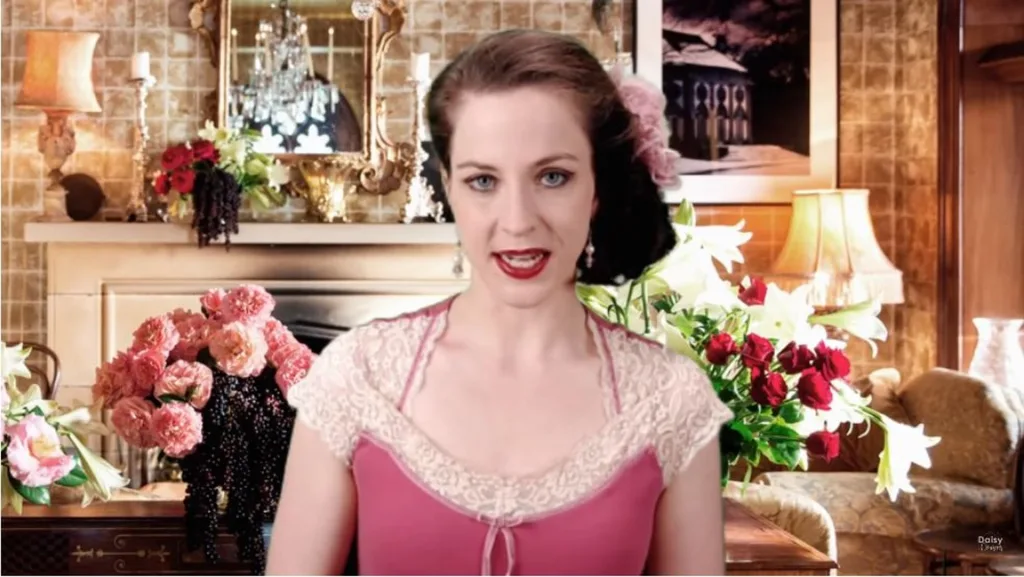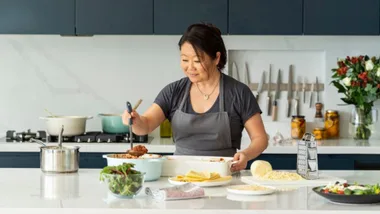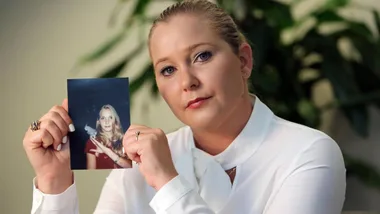“Toxic femininity is real!” says a steely-eyed woman dressed in a black lace top and bright red lipstick with a red rose tucked behind her ear, the artificial background in her video strewn with flowers and frilly lampshades. The woman is Daisy Cousens and she’s one of the leading lights in the female alt-right influencer movement in Australia. She has more than 200,000 subscribers on YouTube, posting regular videos with names like “Why pretty women should NEVER be feminists” and “Leftism makes young women MISERABLE!”
Cousens, who occasionally works as a mainstream journalist and holds views that are very conservative but not extreme, is one of a growing number of female influencers who have recently become players in various conservative – or at the end of the spectrum, far-right extremist – movements around the world, a sphere traditionally dominated by men.
These women come in various guises. Some, like Cousens, could just be called deeply conservative rather than extremist. But others, such as Americans Lana Lokteff and Hannah Pearl Davis, front media channels that attack everything from feminism and immigration to transgenderism and vaccines.
Yet more have transitioned their views into the political sphere, such as Islamophobic activist Laura Loomer, who secured the Republican nomination for a seat in Florida in 2020 and is now reportedly being courted by Donald Trump for his 2024 White House campaign. And others, almost too numerous to count, are adorned with blonde braids and floral milkmaid frocks, and adhere to the “trad wife” movement, an Instagram- friendly trend that ostensibly promotes 1950s-style patriarchal family values, but at its most extreme dovetails with hard-right political dogma.
“Women are crucial to spreading ideology with a smile and making it seem palatable,” Seyward Darby, author of Sisters in Hate, told Vice World News. “It’s about putting a gloss on it.”
There’s no clear data about how many women are players in what can loosely be called the far right or alt right, not least because the movement itself is so fractured and segmented (it’s made up of everything from armed militia like the Oath Keepers, hate groups like the Proud Boys and Christian nationalists, QAnon conspiracy theorists and various shades of racists, sexists and homophobes, to traditionalists who hold extreme regressive views in terms of gender and race politics).

At the pointy end of the spectrum, we do know that far-right terrorism itself is increasingly a threat globally. Data from the 2019 Global Terrorism Index found a 320 per cent increase in violent activities undertaken in the name of far-right beliefs in the West in the five years leading up to 2018. In Australia, ASIO has reported increasing far-right threat activity for several years.
But although women are beginning to show up more regularly at real-world manifestations of far-right activity – a number were at the heart of the January 6 Capitol riots following Donald Trump’s electoral defeat in 2022 – their sharpest weapon tends not to be a sword or knife, but the internet.
In the age of selfies, likes and followers, women are playing an increasingly prominent role in amplifying and broadcasting the far-right’s messages, and doing it in a way that makes them look more attractive, to both women and men. “Although I think women are too emotional for leading roles in politics, this is the time for female nationalists to be loud,” Lana Lokteff told a rally in Sweden shortly after Trump took office in 2017. “Why? Men. Women have a special power to inspire and motivate men.” Later, she added coyly, “I guess, to be really edgy, it was women that got Hitler elected.”
Julia Ebner is a research fellow at the Institute for Strategic Dialogue, and with Jacob Davey wrote the paper ‘How Women Advance the Internationalization of the Far-Right’. “As the spectre of internationalised right-wing extremists continues to grow, the success of women in the virtual sphere becomes particularly problematic,” they wrote. “These broadcasters [are] often serving as a soft introduction to hard-edge ideology, facilitating the ‘red-pilling’ [meaning a political awakening] of individuals who are vulnerable to radicalisation.”
In 2016, one seismic – and very visual – event seemed to turn the tables on the idea that women were merely bystanders in the world of the far right. British neo-Nazi youth group National Action organised a Miss Hitler pageant, where classically attractive white women were paraded as though in a beauty competition and asked to elaborate on their racist views.
“Many comment that they see women at our demonstrations but … they rarely get much spotlight or recognition,” organisers said beforehand. “We organised this competition to give our girls a chance to express their beliefs and share their motivations for embracing National Socialism.”
And embrace it they did. The eventual winner, a Scottish woman whose identity was concealed, shared her anti-Semitic views with the audience and declared that if she could kill anyone on earth it would be former German Chancellor Angela Merkel, because of her support for refugees.
If you trawl back through far-right archives on the internet, the year 2016 seemed to be a turning point for women emerging on the far right. This was the year that right-wing fringe thinking as a whole was granted a brand new legitimacy with the US presidential nomination and eventual victory of the openly xenophobic champion of the alt-right, Donald Trump.

A post from that era on the juggernaut white nationalist message board Stormfront has women wondering how they can recruit more of their own into the fold.
“When I look at people from a White Pride event I don’t see very attractive people; it’s mostly overweight bald guys,” reads one message from 2016. “I would rather go to a White Pride event and see people looking like Taylor Swift. If we strive as a group to [look] our best then women will want to join.”
Another respondent adds, “I think a gentle approach is best. While it’s easy to get up in arms and take a more aggressive approach, you’d have a higher chance of success if you were to do something like holding workshops to the tune of ‘Young women – enjoy your European heritage and explore the culture and crafts of your people.’”
That suggested workshop name would work perfectly as an overarching slogan for the “trad wife” movement, which, at its most sinister apex, is the precise example of the “gentle approach” to leading people into white supremacy advocated by that Stormfront poster. Trad wives, which is believed to have begun around 2013 on an old internet forum called “Red Pill Women”, can be found in all corners of the internet. They advocate living according to traditional gender roles: a man working out of the home to support his family, while the wife takes care of the children and household.
Their aesthetic (trad wives are almost always white, often blonde, and favour WWII-era hairstyles and dirndl dresses) and attitude hark back to the Kinder, Küche, Kirche (“children, kitchen, church”) doctrine popular in Germany from the late 19th century.

To be clear, many women who call themselves trad wives advocate for nothing more alarming than bread baking or popping on lippy before their husbands get home from work.
There’s nothing wrong with dressing conservatively or reverting to pre-feminist gender roles, if that’s what a woman chooses to do. But Dr Kristy Campion, senior lecturer in terrorism studies at Charles Sturt University, says matters become concerning when trad wives begin amplifying the political views of the far-right, giving them a sheen of authenticity. “These women often support anti-feminism, which is also championed by the men of the movements,” says Campion. “That gives [men] reinforcement or validation.”
And it may not stop with anti-feminism. “You also see them being quite homophobic and transphobic,” says Campion. “They may use their Christian values to reject the teaching of gender identity in school. They tend to present themselves as the protectors of children.” A far-right trad wife called Lacey Lynn recently demonstrated that her commitment to submission has waded into the realm of violence, tweeting there is “no such thing as marital rape”, adding that “marriage is consent.”
The trad-wife movement also produced the “white baby challenge”, which began when white nationalist Ayla Stewart, known online as Wife with a Purpose, declared, “As a mother of six, I challenge families to have as many white babies as I have contributed.” More white babies, fewer of any other, the theory goes.
Creating a permissive environment for these views is what concerns terrorism experts like Campion. The rhetoric is partly about pointing to others (immigrants, Jews, Indigenous Australians, LGBTQ people, etc) and blaming them for your problems, but it’s also about presenting an attractive, almost utopian vision of an alternative.
“[Far-right influencers] provide this set of behavioural norms so people who are feeling lost, alienated or hopeless can absorb it and create what we call ‘identity certainty’,” says Campion. “For people who feel that the modern world is out of control, or never know where they stand, that can have a really powerful effect on their involvement in a movement.”

Once you strive to live in that paradise – one that is, of course, largely a fantasy curated for social media – you begin accepting new standards of morality. And, in extreme cases, that morality legitimises violence against your enemies. “It’s something that terrorism scholars have talked about for decades – the dark marketing tactics of terrorism,” says Campion. “It’s not just about violent imagery, it’s also about nostalgic and romanticised visions.”
The remedies to the amplification of far-right views online are anything but straightforward. For a while, various social media companies blocked or banned many of the loudest proponents on mainstream platforms, but anyone with a few basic googling skills could still track them down on their own platforms or alt-right social sites like Parler, Gab or Truth Social.
Today, under the leadership of Elon Musk, Twitter – now X – has walked back its censorship of these individuals and groups, giving them a fertile field in which to recruit members. But his wholesale embrace of their unpalatable messages is making it far harder for him to monetise the platform.
From a policing perspective, while authorities have increased monitoring of far-right groups, Campion says little can be done unless an individual or group makes credible threats or uses language that directly incites terrorism or violence. Urging women to make more white babies or reject feminism in favour of cooking for your husband doesn’t exactly meet the threshold.
But what is crucial is that law enforcement, citizens and even parents should remain vigilant about the reality that extremism isn’t limited to one gender. “Women and girls get involved for the same reasons as men and boys,” says Campion. They may just be hiding it behind lipstick and a freshly baked cake.
This article origionally appeared in the September issue of marie claire Australia.










